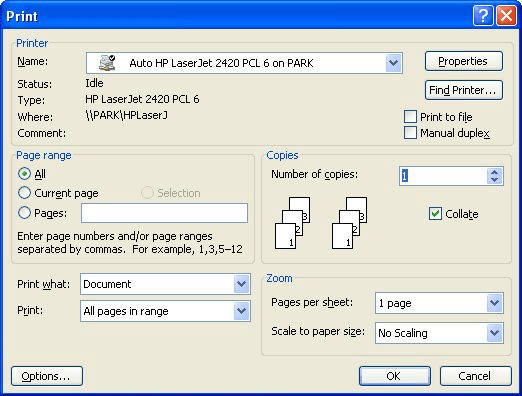Please Note: This article is written for users of the following Microsoft Word versions: 97, 2000, 2002, and 2003. If you are using a later version (Word 2007 or later), this tip may not work for you. For a version of this tip written specifically for later versions of Word, click here: Printing without Track Changes Marks.
Written by Allen Wyatt (last updated October 29, 2022)
This tip applies to Word 97, 2000, 2002, and 2003
Track Changes is a handy feature to use when editing a Word document. The marks let you know what edits have been made, and are particularly useful if you have multiple editors working on the same document. You may, at times, want to print a document before the changes have been resolved and not have the Track Changes marks show on the printout. You can accomplish this task by following these steps:

Figure 1. The Print dialog box.
The printout should not show your Track Changes marks. The marks are only printed if the Print What drop-down list (step 2) is set to Document Showing Markup.
It is important to understand that Word changes the value of this drop-down list, by default, depending on whether there are any tracked changes in your document or not. If there are not, then Document is the default setting for the drop-down. If there are tracked changes (whether you have Track Changes currently on or not) then Document Showing Markup is the default. This is why, if you have tracked changes and you want them not to show in the printout, you must display the Print dialog box instead of just doing a straight printout (using the Print tool) or a Print Preview.
Of course, Track Changes is one of those features that Microsoft has messed around with over the last several versions of Word. Therefore, the above approach may not work in your version of Word. For instance, in Word 97 or Word 2000 you should instead choose Track Changes from the Tools menu and then clear the Highlight Changes in Printed Documents check box.
WordTips is your source for cost-effective Microsoft Word training. (Microsoft Word is the most popular word processing software in the world.) This tip (346) applies to Microsoft Word 97, 2000, 2002, and 2003. You can find a version of this tip for the ribbon interface of Word (Word 2007 and later) here: Printing without Track Changes Marks.

Do More in Less Time! An easy-to-understand guide to the more advanced features available in the Microsoft 365 version of Word. Enhance the quality of your documents and boost productivity in any field with this in-depth resource. Complete your Word-related tasks more efficiently as you unlock lesser-known tools and learn to quickly access the features you need. Check out Microsoft 365 Word For Professionals For Dummies today!
The Track changes feature in Word is a great help in editing documents, particularly if you are working with others or ...
Discover MoreIf you have a group of people working on a single document, you may wonder what tools are available in Word to facilitate ...
Discover MoreWhen a group of people edits a document with Track Changes turned on, it can be tempting for one of the editors to use ...
Discover MoreFREE SERVICE: Get tips like this every week in WordTips, a free productivity newsletter. Enter your address and click "Subscribe."
There are currently no comments for this tip. (Be the first to leave your comment—just use the simple form above!)
Got a version of Word that uses the menu interface (Word 97, Word 2000, Word 2002, or Word 2003)? This site is for you! If you use a later version of Word, visit our WordTips site focusing on the ribbon interface.
Visit the WordTips channel on YouTube
FREE SERVICE: Get tips like this every week in WordTips, a free productivity newsletter. Enter your address and click "Subscribe."
Copyright © 2026 Sharon Parq Associates, Inc.
Comments